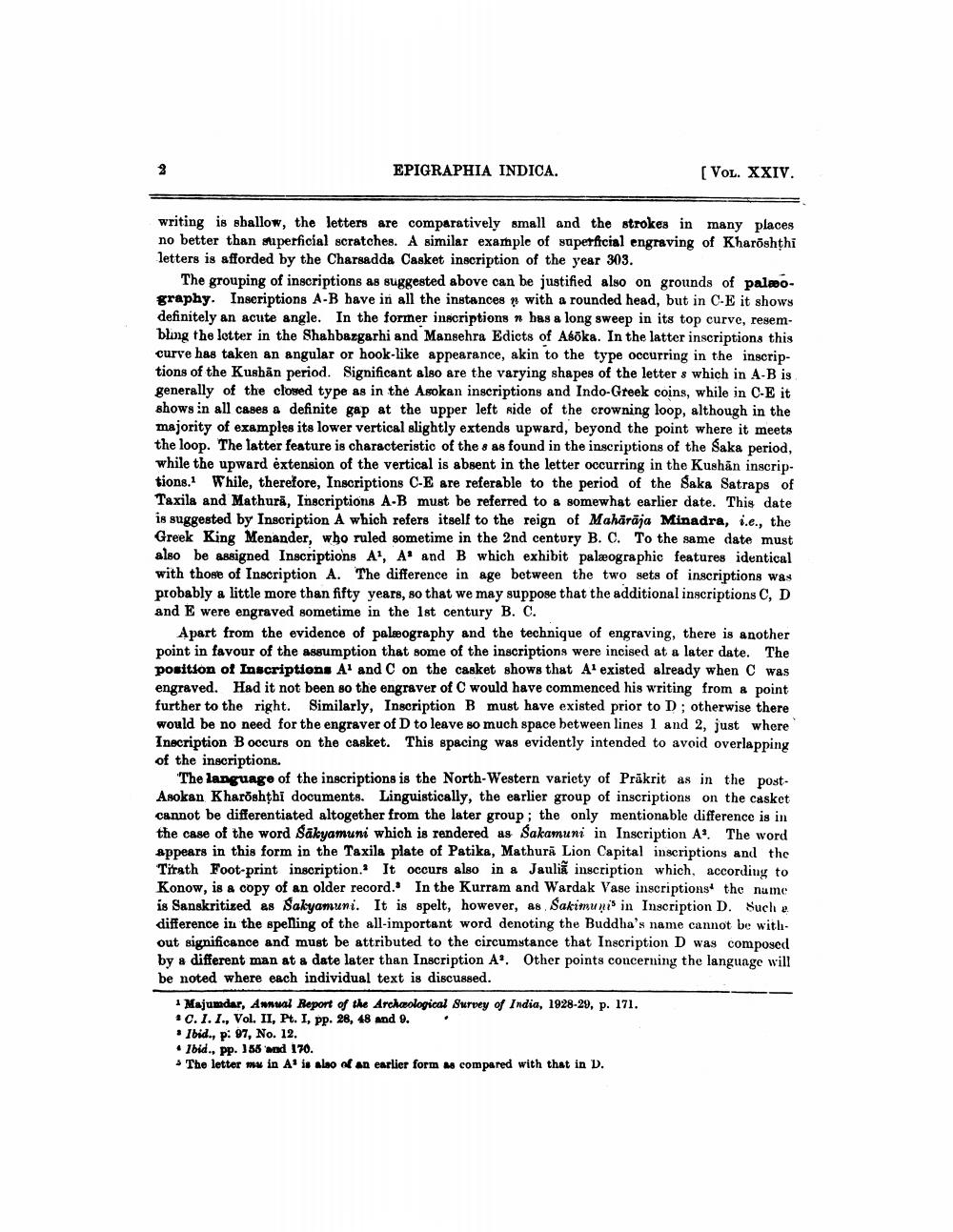________________
2
EPIGRAPHIA INDICA.
[VOL. XXIV.
writing is shallow, the letters are comparatively small and the strokes in many places no better than superficial scratches. A similar example of superficial engraving of Kharōshṭhi letters is afforded by the Charsadda Casket inscription of the year 303.
n
The grouping of inscriptions as suggested above can be justified also on grounds of paleography. Inscriptions A-B have in all the instances with a rounded head, but in C-E it shows definitely an acute angle. In the former inscriptions n has a long sweep in its top curve, resembling the letter in the Shahbazgarhi and Mansehra Edicts of Asoka. In the latter inscriptions this curve has taken an angular or hook-like appearance, akin to the type occurring in the inscriptions of the Kushan period. Significant also are the varying shapes of the letter s which in A-B is generally of the closed type as in the Asokan inscriptions and Indo-Greek coins, while in C-E it shows in all cases a definite gap at the upper left side of the crowning loop, although in the majority of examples its lower vertical slightly extends upward, beyond the point where it meets the loop. The latter feature is characteristic of the s as found in the inscriptions of the Saka period, while the upward extension of the vertical is absent in the letter occurring in the Kushan inscriptions. While, therefore, Inscriptions C-E are referable to the period of the Saka Satraps of Taxila and Mathura, Inscriptions A-B must be referred to a somewhat earlier date. This date is suggested by Inscription A which refers itself to the reign of Maharaja Minadra, i.e., the Greek King Menander, who ruled sometime in the 2nd century B. C. To the same date must also be assigned Inscriptions A1, A and B which exhibit palæographic features identical with those of Inscription A. The difference in age between the two sets of inscriptions was probably a little more than fifty years, so that we may suppose that the additional inscriptions C, D and E were engraved sometime in the 1st century B. C.
Apart from the evidence of paleography and the technique of engraving, there is another point in favour of the assumption that some of the inscriptions were incised at a later date. The position of Inscriptions A1 and C on the casket shows that A1 existed already when C was engraved. Had it not been so the engraver of C would have commenced his writing from a point further to the right. Similarly, Inscription B must have existed prior to D; otherwise there would be no need for the engraver of D to leave so much space between lines 1 and 2, just where Inscription B occurs on the casket. This spacing was evidently intended to avoid overlapping of the inscriptions.
The language of the inscriptions is the North-Western variety of Prakrit as in the postAsokan Kharoshṭhi documents. Linguistically, the earlier group of inscriptions on the casket cannot be differentiated altogether from the later group; the only mentionable difference is in the case of the word Sakyamuni which is rendered as Sakamuni in Inscription A3. The word appears in this form in the Taxila plate of Patika, Mathura Lion Capital inscriptions and the Tirath Foot-print inscription. It occurs also in a Jauli inscription which, according to Konow, is a copy of an older record. In the Kurram and Wardak Vase inscriptions the name is Sanskritized as Sakyamuni. It is spelt, however, as Sakimunis in Inscription D. Such a difference in the spelling of the all-important word denoting the Buddha's name cannot be without significance and must be attributed to the circumstance that Inscription D was composed by a different man at a date later than Inscription A. Other points concerning the language will be noted where each individual text is discussed.
1 Majumdar, Annual Report of the Archaeological Survey of India, 1928-29, p. 171.
* C. I. I., Vol. II, Pt. I, pp. 28, 48 and 9.
Ibid., p. 97, No. 12.
Ibid., pp. 155 and 170.
> The letter mu in A3 is also of an earlier form as compared with that in D.




